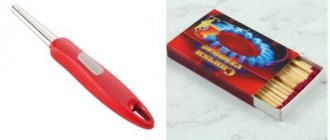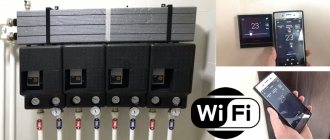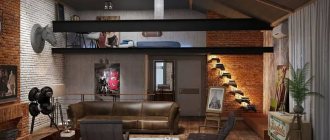The modern era of advanced smartphones and the global Internet offer users the opportunity to use advanced management and control systems. Many people use chillers and VRF systems. But the greatest demand today is for remote control. Thanks to this, you can ensure that the house does not freeze, and that a minimum positive temperature is always maintained in all rooms.
Universal remote system for phone and tablet
Ideal for a classic cottage
In remote regions of Russia, the market offers a relatively small range of heating units. Most often, dachas are heated with compact stoves burning coal or wood; in the best case, the owners of such real estate can install a solid fuel boiler or electric radiators. But even with implemented systems running on diesel fuel and natural gas, universal automatic switching is not always provided. The only viable option in this case is to use electricity. But since the use of such heating units is quite expensive, it is better to use this method as an auxiliary one.
The remote control method allows one or several rooms to be heated to the specified level before the owner arrives, while ensuring the stable functioning of the sewerage and water supply systems. After which you can start the main heating system in a comfortable environment, but only in manual mode.
The evolution of modern technology
Wireless transmission
Transmitting and distributing current to consumers without the use of wires is the reality of our days. Nikola Tesla was the first to think about this method and bring it to life. Currently, developments are underway in this direction. There are only 3 main ways.
Reels
Inductors are insulated wires rolled into a spiral. The current transmission method consists of 2 coils located next to each other. If an electric current is applied to one of the coils, a magnetic excitation of the same voltage will appear on the second. Any voltage changes at the transmitter coil will change at the receiver coil. This method is very simple and has a chance to exist. But there are also disadvantages:
- there is no way to supply high voltage and receive it, thus it is impossible to provide voltage to several consumers at the same time;
- it is impossible to transmit electricity over long distances;
- The efficiency factor (COP) of this method is only 40%.
At the moment, methods for simply using coils as a source and receiver of energy are relevant. This method is used to charge electric scooters and bicycles. There are projects of electric vehicles without a battery, but with a built-in coil. It is proposed to use the road surface as a source and the car as a receiver. But the cost of laying such roads is very high.
Laser
Transmission of electricity through a laser is a source that converts electrical energy into a laser beam. The beam is focused onto a receiver, which converts it back into electricity. The Laser Motive company was able to transmit 0.5 kV of electric current using a laser over a distance of 1 km. At the same time, the loss of voltage and power amounted to 95%. The cause of the loss was the Earth's atmosphere. The beam narrows many times when interacting with air. The usual refraction of the beam by random objects can also become a problem. A similar method, without loss of power, can only be relevant in outer space.
Microwave transmission
The basis for transmitting electricity by microwaves was the ability of 12 cm waves, with a frequency of 2.45 GHz, to be invisible to the Earth's atmosphere. Such a feature could reduce transmission loss to a minimum. This method requires a transmitter and a receiver. People have long created a transmitter and converter of electrical energy into microwave energy. This invention is called a magnetron. It is included in every microwave oven and is very safe. Problems arose with the invention of the receiver and converter of microwaves back into electricity.
In the 60s of the last century, the Americans invented the rectenna. In other words, a microwave receiver. With the help of the invention, it was possible to transmit 30 kW of electric current over a distance of 1.5 km. At the same time, the loss rate was only 18%. The installation was not capable of more due to the use of semiconductor parts in the receiver device. To receive and transmit more energy power using a rectenna, it would be necessary to create a huge receiving panel. This would increase the energy expended, frequency and wavelength, and therefore the percentage of associated loss. High radiation could kill all living things within a radius of several tens of meters.
In the USSR, a cyclotron converter of microwaves into electricity was invented. It was a 40 cm tube and was completely assembled using lamps. The efficiency of the device was 85%. But for this method, the main disadvantage is the assembly method using lamps. Devices based on such parts can return humanity to the world of huge phones and room-sized computers. You can forget about miniature electrical appliances.
Microwave transmission could be organized from space. A similar project involved collecting solar energy using a satellite and redirecting it to a receiver located on the surface of the Earth. But to do this, you will have to build a satellite with a diameter of a kilometer and a receiver with a diameter of 5 kilometers. You can completely forget about flying within the system's coverage area.
The main problem when transmitting electricity wirelessly is distance and atmospheric refractions. It is also worth considering power. The total power consumption of all electrical appliances in the apartment is 30–40 kW. To provide electricity to one apartment, gigantic structures would have to be built.
Today, the only way to transmit high-power energy is wired. It does not require direct and reverse conversion of electrical energy. It is enough just to apply a high voltage at the beginning and significantly lower it at the end. This method has a number of disadvantages, but remains relevant for many years.
High quality GSM sockets
Timely remote switching on of a heater in use in a small dacha using such a device is the best option. It is best if there are two adjacent rooms, and the total number of convectors in power does not exceed 3.5 kW, since this figure is the permissible load for one outlet. Of course, some advanced models allow you to connect an electronic device with a maximum load of 4 kW.
The GSM socket is very convenient and practical to use. The user only needs to connect all the heaters one by one and plug the unit into a regular wall outlet. The device has a special sensor for measuring the ambient temperature. If there are many rooms in the dacha, and all the heaters are plugged into one outlet, then in the main room the air will warm up to the required level, but in all the others it simply will not have time. The whole point is that the infrared temperature sensor will switch off exactly at the moment when comfortable conditions are created in the room where the GSM device is located.
Important! The adapters in question do not have a battery, which is why in the event of an unscheduled power outage they also cease to perform their functions. The device will inform the user in advance about the current situation. After 3 minutes the system resets. After turning on the power, you must again make the desired request and send the command.
Only advanced models can boast of having an autonomous power source. Such a device retains all the settings made even after the power supply is restored.
How it works
The devices are based on the ESP8266 microcontroller. He is responsible for connecting to Wi-Fi and he is also responsible for processing commands and controlling the power relay. On the Internet you can find instructions, diagrams and firmware for self-assembly of such a relay, but given the low cost of Sonoff (from $4), this is not rational, unless it will be interesting for electronics enthusiasts.
The device operates not within your home network, but through a cloud server. That is, you need to connect to the Internet from your smartphone to control electrical appliances. In the absence of the Internet, even if Wi-Fi works, not all devices from the line will work, for example, wireless control without Internet access is possible on the RF and Basic models. But if your relay does not work without the Internet, you can control connected devices by pressing the button located on its body.
To connect this Wi-Fi relay with a smartphone you need:
- Download the eWeLink application and register in the application.
- Connect the relay, press and hold the button on its body.
- Release the key when the LED indicator blinks.
- After that, in the application you need to click on “search for devices” and set the network connection parameters.
- Next, come up with a device name.
- Now you can begin to fully use the device.
The ability to control your devices from anywhere in the world is the main advantage of Sonoff working via the Internet, rather than a local Wi-Fi network. This approach allows you to organize remote heating switching on before traveling to a country house or automate the watering of plants.
High quality GSM block module
This device should be included in the electrical circuit if the house has a large area and many rooms. This block module does an excellent job of controlling all convectors in the house via a contactor, power relay, or expansion relay boards. In this case, professional installation will be required. There is enough free space in the internal compartment of the device to install a SIM card. It is better to choose an operator that has reliable signal distribution; you also need to remember to deposit money into your account.
The module is equipped with a battery that supports autonomous operation for 12 hours. In this case, manufacturers have provided a whole list of commands for controlling convectors; the user can also independently connect additional options to increase the autonomy of the product. The following functions are available from a regular mobile phone:
- Maintaining optimal temperature of heaters.
- Simultaneous connection of up to 5 sensors using a contactor.
- Remote adjustment of temperature control settings in the entire house or individual rooms.
- Using a backup battery.
- Continuous monitoring of the presence of 220V voltage in the network.
- Automatic display of information about the temperature in the house.
- Emergency notification via SMS about failure of engineering equipment.
Demanded GSM based system
Control of district heating boilers
For example, we used the GSM alarm controller Block-Post 4, manufactured by EDS LLC.
This device allows you to control the temperature in 8 zones at a distance of up to 100 from the main device. Although the device is intended primarily for an alarm system, its latest firmware has extensive capabilities for working with temperature indicators and the corresponding external periphery:
- Range of perceived measurements -40°С…+120°С with an accuracy of half a degree;
- There is built-in protection against freezing of the coolant; you just need to indicate which channel receives information from the detector and the limit value. If it is exceeded, an SMS warning is sent;
- There is a WEB interface with the ability to maintain statistics and visualize temperature graphs for the period for each temperature sensor;
- You can program the maintenance of a given temperature regime and the prevention of freezing of the heating system.
This device has several advantages compared to others regulating the same functionality. First of all, all modules, including the GSM modem and UPS (up to 12 hours of autonomous operation), are built inside the case, which greatly simplifies its installation and configuration. After the SIM card is installed, the controller automatically connects and registers on the developers’ WEB service, which is located at https://monitoring.gsmbps.ru/. Using standard visualization shell tools, you can easily program the device to perform many functions without knowing any programming language. Connection directly to the boiler is made through relay outputs.
In addition, developers are constantly improving both the hardware of the device and firmware, as well as the software on the server. The only limiting factor to the widespread use of BlokPost controllers is their rather high cost and poor compatibility with devices from other manufacturers.
Carrying out control stationary, as well as using SMS commands
To turn on the heaters in a timely manner, you need to place a classic SIM card in the module. The necessary command is transmitted from any smartphone, after which the device will communicate with the control unit and the convectors will be configured via radio signal. You can also install a universal program, thanks to which you can specify the following parameters: on and off times, room temperature. In remote mode, you can completely reconfigure the system. In addition to this, the unit is equipped with outputs for connecting to alarm sensors.
An accessible and easy-to-use device
Multifunctional Wi-Fi
In this case, experts recommend using Energy Control. You can download this program to any phone, which stands out for its versatility and practicality. The purchased unit is connected to the router and provides a good connection to the Internet. At work or while driving around the city, you can control convectors, adjust the air temperature, and monitor the performance of the entire system. You can simultaneously make all the necessary corrections from more than 250 smartphones.
Important! Today, Nobo is the only company that is actively working in this industry. Specialists continuously modernize and expand the functionality of the equipment they sell.
The video provides instructive information on how you can remotely control your home heating:
Remote systems NOBO Energy Control
It is quite easy to use such developments of specialists. Control is carried out through a single center - Orion 700 devices. Auxiliary elements allow you to remotely control absolutely all electrical appliances and convectors. The user can remotely control energy consumption. Experts made sure that the temperature was maintained exactly to 1 °C. Radiators are turned on and off according to a given program, and the universal built-in timer can be programmed not only for a day, but also for a whole week. Thanks to this, the final electricity consumption is reduced by 30%, but without compromising the comfort of living.
Activation of heating at a certain time
To create optimal living conditions at your dacha, you can set your arrival time in advance. This option suits many modern users with its accessibility and simplicity. To work, you need to purchase a reliable automation relay. The timer is installed in a circuit with an electric heater and the optimal turn-on time is simply set.
Advice! If arrival at the dacha is planned at eight in the morning, then you need to set the relay for 5 o’clock. During these 3 hours, the air in the rooms will warm up well.
To significantly save money, heating can not be turned on in all rooms. In the living room and bathroom it is enough to bring the temperature to +12 °C. Even if a person comes in from slightly frosty conditions, such conditions will be comfortable. To avoid wasting electricity if the train is cancelled, you can turn off the heating remotely.
A popular device for remote use
Sending commands from a smartphone
This option is more convenient to use, but you need to spend more money on it. In order to send a remote command that will notify the equipped system that it is time to prepare for the arrival of property owners and turn on the heating, you need to buy a GSM module. This device is a regular switch that is responsible for connecting when calling from a phone. You can enter several numbers into the unit’s memory at once, calls from which will be perceived as commands. The product must be installed in a common switchboard and high-quality electric radiators are connected through it. To have a warm room waiting for you upon arrival at your dacha, you just need to call from your smartphone or send an SMS. If you had to be delayed or the train was suddenly cancelled, then just make another call to turn off the heating.
Important! The device fits perfectly with a SIM card from any mobile operator. It is best to opt for the option that provides the highest quality communication in a certain region.
Self-installation of purchased socket
Cheap system for controlling electrical appliances - using the example of SonOff
Today, the trend of home automation is popular in technology: smart homes, smart household appliances that are controlled from a smartphone, and so on. But what to do if a radical rework of the electrical network and replacement of all household appliances with “smart” ones is beyond your means, or you just want to do something with your own hands that cannot be bought? Wi-Fi relays will help solve this problem.
Sonoff is a prominent representative of this type of device. This is a whole family of Wi-Fi relays developed by ITEAD Studio, which also offers us a whole line of various products - Wi-Fi sockets, “Smart” LED strips, “smart” lamp sockets (Slampher) and so on.
DIY electronics in a Chinese store.
Maintaining positive temperature in the house automatically
Water supply is directly related to heating. If you rarely go to your dacha in winter, then you shouldn’t be too smart about the water supply. You can bring the necessary supply of liquid with you for several days, or store it in capacious plastic containers from the summer. If the dacha is visited quite often, and the water is used not only for drinking, but also for showering and sewage, then this property is used as a country house. In this case, smarter systems are needed than the classic remote switch.
If the house is periodically subjected to freezing and thawing, this is fraught with accelerated deterioration of the property’s finishing, which will force the owners to spend additional money on unscheduled repairs.
The assembly of more complex remote systems needs to be done if it is planned not only to provide high-quality heating of rooms, but also to electrically heat sewerage and water supply systems, as well as constantly maintain positive temperatures. Expensive models of boilers that operate on gaseous or liquid fuel and are equipped with a thermostat are equipped with similar functions.
Important! Heating of water pipes is based on the fact that they are wrapped in a spiral with a heating cable cord, and then covered on top with a warm sleeve, which is made of foamed polyethylene.
Affordable GSM device from a domestic manufacturer
Remote automatic heating of a standard dacha as an integral part of the overall scheme
A professional approach to real estate heating allows the equipment involved to function stably in various modes. With the right approach, you can combine several systems at once to achieve a good result. This remote correction option does not have a central controller. But at the same time, a fairly large percentage of the unused capabilities of the units can be used in other “smart home” schemes. Even a classic GSM module is capable of not only receiving incoming calls, but also sending reports about the situation in the house to a smartphone. Thanks to this, you can quickly find out about a flood or a starting fire.
Sonoff PRO is a wifi module for remote load control
It would be nice to buy such a cheap one for convenient control of all electrical appliances in the house from a smartphone at any distance. The module is intended for a smart home, or simply as a single instance for controlling one device. The company promotes its products on the Russian market, and not only on it.
Smart home device
With this device you can control, for example, a computer at any distance from it. The main thing is to have access to the Internet. For example, we are driving home by car. We wanted some hot tea. Turn on the Sonoff PRO relay. When we arrive, the kettle will boil. Or turn on the heater in the garage in advance.
The relay is sold in this Chinese store. Check out the prices. It's quite inexpensive.
In the last video, the author liked the quality of the case. Well, really, don’t find fault. The plastic is so good, dense, durable. It seems like a small thing, but it spoils some of the overall impression of the device, of the device. Well, couldn't you have put 4 small self-tapping screws? To do this: twist the wires, put them with a lid and tighten these 4 self-tapping screws. But no, you have to look somewhere, walk, look, this box, look for these self-tapping screws, 4 such tiny screws. The connection is extremely simple: here is the input 220, and from here the output 220. There is one button with which we will connect, and a two-color LED indicator indicating whether this device is connected to the wifi network or not connected. Also, if we get a little splurged and spend a few extra bucks, this module will come with a remote control. That is, it will be possible to control not only using a smartphone, but also using a regular remote control.
Products for inventors. Sale from 10 to 15 January. Link to the store.
Let's open the box with the device and see what's inside. It's not that easy to open. The author is afraid to break his nails. You'll have to ask the tool for help. We look, and the first time it seems easy. Immediately everything fell into pieces, on different sides. Such a scarf and that's it. There are 2 terminal blocks on the board, input - output, part of the power supply, a capacitor of 3 and 3 microfarads, 400 volts, a tiny transformer. On the secondary winding of the transformer, well, that is, at the output of the capacitor there are 16 volts, 70 microfarads. Relays that switch the load. Judging by other reviews, the relay is rated at 10 amps. Let's see, 5 volts need to be supplied to it, to the winding, and 10 amperes. 10 amps, 250 volts, 5 volts. But, for some reason, many do not believe that it can withstand 10 amperes. Next, from 4 minutes on, there is a video about a device that is cheap, but allows you to control household electrical appliances from a distance.
The feasibility of remote control of functioning heating
Various heating cables, radiators, and boilers are responsible for the most comfortable air temperature in the house. Each unit has its own operating principle and heating functions. The main task of the created system is to heat the room with minimal financial losses. Having remotely set the optimal parameters of the desired temperature, the user sets a specific control program. Control can be carried out either automatically or manually. Thanks to this, the rooms will be maintained at the most suitable temperature. This approach allows you to control the functioning of not only the entire system, but also individual working units, which is very convenient and practical. The equipment will independently make the necessary adjustments when it gets warmer or colder outside.
Rational use of electric heaters in a private home
Methods of transmitting electricity
Electricity, or alternating current, is transmitted from source to consumer through wires or underground cable lines. These methods have been relevant for many years. This is due to the fact that there is no technology capable of transmitting electricity over long distances with minimal losses while maintaining full power. And the method must also be as reliable and cheap as possible.
The transmission circuit of alternating electrical voltage or direct electrical voltage is as follows:
Working principle and circuit explanation:
- At the beginning of the circuit there is a generator that produces electricity.
- From the generator, voltage is supplied to a three-phase transformer to increase power. From it, electricity flows through power lines (power lines).
- After the power line, the voltage goes to a three-phase step-down transformer.
- The voltage is supplied to the consumer from the transformer, with a significant understatement.
For direct current, there is a rectifier device, which is located after the step-up transformer. Having passed along the power line, the direct current must first get to the device that converts direct current into alternating current, and only then to the step-down transformer.
Overhead and cable lines
Electricity consumption via overhead power lines and cable lines represents a certain pattern. At the beginning of the circuit there is a source of energy, namely a power plant. The power plant supplies overvoltage to the distribution line, at the end of which there is a step-down transformer. The main disadvantage of such a scheme is precisely the need to supply too much power. This is due to the loss of some voltage over a distance. There are 2 ways of such transfer.
Overhead lines are a network of high-voltage wires suspended from poles or supports. This method is very common and effective. But it also has a number of disadvantages:
- high costs in labor and material at the stage of delivery to new consumers over long distances;
- loss of a significant share of power with every kilometer;
- requirement for high power supply at the beginning (from the power plant);
- harm from the magnetic field to humans;
- high probability of damage and destruction from natural disasters;
- great difficulties for the installation of power lines in difficult, impassable regions.
Overhead lines supply alternating current to the consumer. Based on range and power, they are divided into the following categories:
- Overhead lines with voltages up to 1 kV are considered low voltage. They are the end of the transmission circuit to the consumer.
- Lines with voltage from 1 to 35 kV are considered medium.
- High-voltage lines are considered to be VEL with a voltage of 110-220 kV. These lines are the beginning of the voltage transmission circuit.
- Ultra-high-voltage ones include VEL with a voltage of 330–750 kV.
- Ultra high-voltage ones include VEL with voltage exceeding 750 kV.
The higher the applied voltage, the longer distances it must cover from source to consumer.
Cable lines work on a similar principle. They also carry alternating electric current. But such lines are drawn underground or under water. The main disadvantages of such a transfer are:
- Great difficulties and costs during installation. Cable lines are laid in places where it is impossible or dangerous to lay overhead lines.
- There is also a loss of voltage with distance.
- There is a risk of mechanical damage or stretching of the cable.
- There is a danger of step voltage if damaged, especially in water.
- It is very difficult to find and repair the damage.
At the moment, there are 2 schemes for transmitting electricity from source to consumer via overhead or cable lines:
- Open circuit. This transmission circuit represents the voltage source and consumer as a straight line. The disadvantage of this scheme is the absence of a backup line in case of damage to any area.
- Closed circuit (more reliable). In it, the source and all consumers are enclosed in a ring or complex circuit. If a section of the line is damaged, the supply of electricity does not stop.
Similar schemes are also divided into categories.
Schemes in visual display:
There are 3 types of open-loop circuit:
- A radial connection diagram in which there is a supply device at one end and an energy consumer at the other end.
- The main circuit is similar to the radial one, but it contains additional outlets for consumption.
- A main supply scheme in which there is one consumer between two sources.
The closed circuit also comes in 3 types:
- Ring circuit with one source and consumer.
- Main circuit with a backup source.
- Complex closed circuit for connecting special-purpose consumers.
All these circuits relate to the transmission of direct current to the consumer. The transmission and distribution of electricity in this way is the same for Russian and foreign networks.
Main advantages
The main positive characteristics of the remote heating control method include:
- Significant cost savings on heating rooms (up to 60%). This effect is achieved due to the fact that in the absence of the owners the boiler can operate in an economical mode.
- Providing additional comfort and coziness.
- For high-quality engineering systems, a real development trend can be considered the possibility of combining them into a single network. Due to this, you can reduce the overall financial costs of maintaining the dacha.
- Significant extension of the service life of devices, ensured by the operation of parts at reduced loads.
Experts have proven that the capabilities of devices for remotely sending operating parameters are becoming more advanced every year. Developers of multifunctional applications for smartphones create innovative devices on the principle that even an untrained person can easily handle them. Now, even over a long distance, you can prevent pipes from defrosting during the cold season. The zonal mode of operation is in great demand, when different rooms can have individual temperatures.
Remote reconfiguration means that any indicators can be changed using a smartphone. It is this approach that is one of the key parts of the ideology of promoting a “smart home”. This approach entails the further rapid development of all engineering systems of the dacha in order to ensure the most convenient creation of comfortable living conditions.
More informative information on this topic is presented in the video:
Average score of ratings is more than 0
Share link
Comments There are no comments yet, but you could be the first...
Model differences
Before considering the Sonoff Wi-Fi relay model range, we note that on the Russian market you can find them in orange and blue packages. In fact, these are the same product, but the models in the orange design are nothing more than an adaptation for the domestic market, sold under the World On brand; I was unable to find more detailed information and differences. But World on also offers additional products, such as a sealed box case with IP66 protection, for example, for using the product underwater or outdoors. At the same time, the light blue packaging is original from ITEAD.
Packaging from World On (left) and ITEAD (right)
Let's move on to an overview of the main models in the line:
- Basic 10A is the basic model in the line. As the name implies, it can withstand current up to 10A, or power up to 2.2 kW. Operating voltage range 90-250V. Range of permissible operating temperatures: operating temperature from 0°C to 40°C. Wireless communication standard - 802.11 b/g/n, Case dimensions: 88*38*23mm.
- RF - similar to the previous one, but can be controlled using a radio remote control operating at a frequency of 433MHz. It is not included in the package, but these remotes are common in various devices and it is possible to bind any one.
- Dual - two-channel, that is, you can connect not one, but two loads. there are two channels. Convenient if you need to turn on different electrical appliances independently of each other and do not need to install two Sonoff Basics. However, there is a nuance - the maximum current for 1 consumer is 10A, and for two consumers it is not 20, as you might think, but only 16 amperes. Keep this in mind when choosing. The dimensions have increased slightly - 114*52*32mm.
- TH10/TH16 - temperature and humidity sensors can be connected to these models, namely: DHT11, AM2301, DS18B20. The latter can only measure temperature. The sensors are connected to the relay using a 3.5 mm jack (standard for headphones) located on the side panel. The differences between TH10 and TH16 are in the maximum load current - 10A and 16A.
- POW 16A - a feature of this model is the ability to monitor the power consumed by the load (daily and monthly reports), which can be useful if you control the operation of heaters, for example. There is also an advanced version - POW R2, which “can” show the voltage value in the network and how much current is consumed by the load at the current moment. Case dimensions: 114*52*32mm.
- 4ch PRO is the largest model in the line, designed for installation on a DIN rail in an electrical panel, where it occupies as many as 8 modules (case size - 145*90*40mm). Using Sonoff 4ch you can control 4 electrical appliances with a power of 2.2 kW each (10 A/channel).
- The largest option in the line. The main feature of the characteristics is to control 4 channels of consumers with a power of 2200W, that is, 10A per channel.











